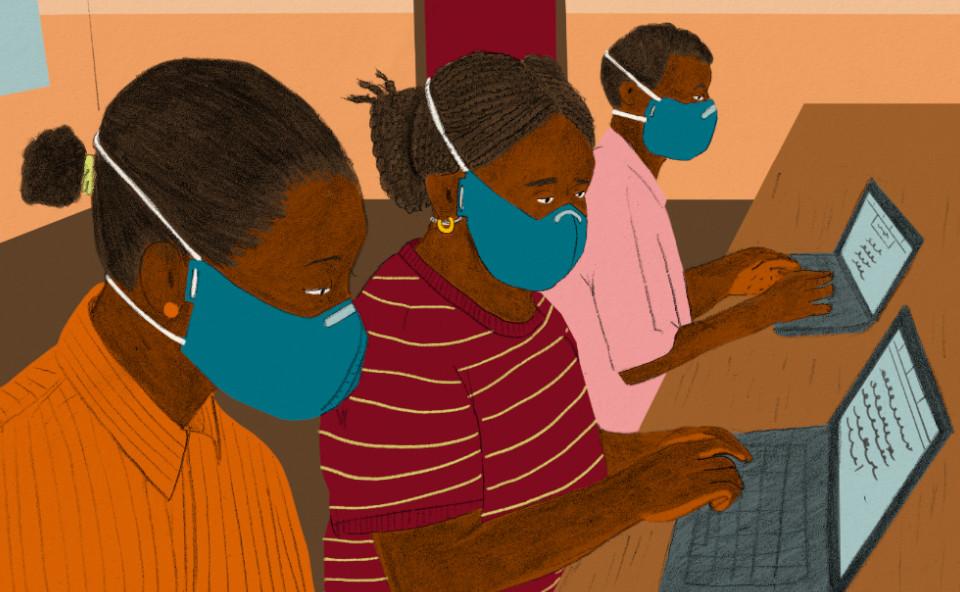
Original illustration by Gustavo Nascimento. Creative Commons BY-NC-SA(link is external).
Introduction
Just over 50% of the world has access to the internet. Women, rural dwellers and marginalised communities make up the majority of those without digital connectivity due to systemic barriers including affordability, access to digital skills and education, language and literacy obstacles and also perceived relevance and social norms. Initiatives to close the gender digital divide need to address systematic inequalities with an intersectional lens to avoid replicating systemic exclusions. Even when intending to be inclusive, the design and deployment of technologies are often underpinned by concepts and frameworks that are not applicable to the lived realities of marginalised groups – while such technologies increasingly shape political, economic and socio-cultural systems and mediate access to the public sphere and human rights. Digital technologies are embedded in structures and systems of power, with mainstream technologies and policies often being developed in institutions and knowledge paradigms, far removed from those whose lives they seek to improve. The design of technological infrastructures is also often centralised, and wholly unaccountable to local knowledge and community governance. The calls for decolonising technology require a resistance to such hierarchical systems, infrastructures and methods, as well as centring the histories of and implications for women and communities in the global South, including marginalised groups.
Immense strides have been made in exploring and implementing alternative modes of connectivity that challenge the androcentric, expensive, top-down approaches adopted by mainstream models. One such alternative is the community network. The internet and its benefits are said to be meaningful when regularly accessed, affordable, of sufficient quality and speed;1 and when individuals are enabled to access information freely, seek their well-being, express themselves, and create content while also actively engaging in development discourses.2 Community networks have emerged as an important participatory and innovative model for delivering meaningful mobile internet connectivity around the world. They respond to the immediate needs and context of the community, where members may be involved at all levels, from the design to implementation of infrastructures.
Women are not homogenous, and their lives are situated along the spectrum of social locations including caste, class, sexuality, geographical location, etc. The provision of equitable access for women, then, cannot be a one-time-only “tick the box” project; nor one that seeks to “add gender and stir” to digital inclusion initiatives. Addressing complexities in society demands localised approaches. Indeed, infrastructure needs to be contextualised to local needs and communities as they exist offline – in a way that ensures that technology is relevant to women's lives. Physical infrastructures are intertwined with social infrastructures. As such, design needs to consider women's everyday realities, aspirations, networks, voices, safety and collective desires from the standpoint of their lived experiences.
Women are not homogenous, and their lives are situated along the spectrum of social locations including caste, class, sexuality, geographical location, etc. The provision of equitable access for women, then, cannot be a one-time-only “tick the box” project.
A mere economic lens is not enough to address the question of the digital divide. Gurumurthy and Chami3 highlight the “naïve" nature of such a framework that looks at an “input access, output empowerment” model. They call for an in-depth engagement with underlying structural inequalities that form the barriers to women’s access to internet connectivity and information and communication technologies (ICTs). Along these lines, they argue for an approach that places the question of gender justice at the foundation of access. The context of empowerment through technologies, and digital equality at large, cannot be divorced from offline experiences and socio-political realities.
The GSMA has identified four enablers to mobile connectivity: infrastructure, affordability, consumer readiness and content and services. These enablers are further split into 19 dimensions. A closer look at these dimensions reveals the obvious economic bias, for example the existence of infrastructure, locally developed apps, greater literacy rates, high mobile ownership, etc. Indicators are conceptualised wherein economically developed nations are known to clearly perform better than “developing nations”. Here, Gurumurthy and Chami4 bring our attention back to another aspect of the divide emerging i.e., the “communications capacity gap”. The authors define this as “…the gap in the capacity to transmit information online, arising from the tendency of developing countries to use low bandwidth, mobile broadband as a replacement for high bandwidth, fixed broadband”.5 It is generally understood that fixed and wireless based broadband networks provide one of the most preferred and commonly used mediums of providing internet connectivity.6 In an insight for the State of Broadband report it is, however, noted that this preferred mode of connectivity becomes difficult to implement due to the high cost of extending optical fibres along longer distances, especially in rural areas. The negative return on investment has dissuaded service providers from making their connections available in these areas. The authors further highlight that most developing countries and organisations around the world have started looking at mobile-based broadband connectivity instead of fixed-based broadband.
Accessing connectivity through the mobile phone is known to restrict the type and numbers of applications that users can use over the internet.7 These same authors believe that the communication capacity gap and reliance and advocacy for mobile broadband networks have been a massive influence on the way women’s “digital inclusion” and “empowerment” have been conceptualised. This remains true for policies which focus only on providing mobile phones to women or increasing their numbers as customers to service providers. Policies on mobile broadband connections need to effectively complement fixed broadband connectivity to ensure meaningful access for women.
To understand the significance of community networks as a solution within discourses of connectivity, it is important to first understand that existing digital infrastructure operates in a broadly unsustainable manner. Data use, generation and computation are growing at an exponential rate in the absence of substantial strategies towards sustainable design, such as scaling, recycling, etc.8 Additionally, existing business models fail to provide last-mile connectivity. Digital infrastructure is not profitable in remote and rural regions where employment, income and education are lower than in urban regions, thus rendering the demand flexible and low.9
Due to this infrastructural gap, community networks present a viable solution, as a low-cost, open-source communication technology, providing a locally owned and operated alternative to connectivity, catering to both fluctuating demands and affordability.10 However, implicit within the discourse of last-mile connectivity, there is a critical lens that questions who these are for, what their significance is and who succeeds in participating in their use and design? Therefore, it is pertinent to be critical of invisibilising vastly different contexts, while also questioning who the community in question includes, leaves out and oppresses.11
Insofar as existing gaps in the research on community networks, there is a need for qualitative research, to bring to light issues of inequality (e.g. gender and caste politics) within communities and identifying whether these are replicated in the creation of community-owned and operated infrastructure.12
Insofar as existing gaps in the research on community networks, there is a need for qualitative research, to bring to light issues of inequality (e.g. gender and caste politics) within communities and identifying whether these are replicated in the creation of community-owned and operated infrastructure.
The politics of gender is reproduced even in autonomous and decentralised technologies and networks. In her paper Women and the Spatial Politics of Community Networks, Bidwell writes about the ways in which power and gender manifest in the use, access and maintenance of community networks. Gender has affected women’s restricted access to public spaces, their mobility across different areas at different times of day and the degree of privacy. Furthermore, traditional gender roles determined the type and amount of work women did and technical work could often not fit easily into their schedule and (or) was incompatible with their training or expertise.13
The spatial politics of access to space and mobilities affects the kind of access different groups of people have to the internet and how they use it. Spaces such as public Wi-Fi hotspots are considered to be neutral, and yet, in a study done in rural India, it was rare to find a group of women “hanging out” in a public spot like the men did.14 As such, access to the internet for women was found to be in the private sphere, i.e., using mobile internet. Public access to the internet was limited to men, who accessed public spaces with far greater ease than women did. Such spatial politics are not limited to some villages in the global South but are prevalent in different degrees and forms across even privileged spaces in the global North.15
The gender politics of accessing space is not limited to problems with accessing space as a physical dimension, but has been prevalent online as well. There, norms around gender, class, race and other forms of identity are reproduced leading to entrenched expressions of digital inequality, manifesting in everyday realities. Furthermore, women and queer and trans communities have constantly been on the receiving end of online harassment and censorship.16
While autonomous and decentralised tools, services and physical hacker spaces are present worldwide, promising a more equitable and feminist future, they are still in embryonic stages, unable to contend with mainstream choices as viable alternatives for large public participation.17
Community networks help us to move beyond the narratives of last-mile connectivity, and engage with the specifics of the political economy, institutionalised power, culture, micro-politics and inequalities present within areas, communities and people, moving towards more convivial, peaceful and plural societies. They seek to transform infrastructures through dispersed ownership and collective, participatory and accountable technologies, relevant to local realities. While access to ICTs creates many positive benefits for women connected by means of community networks, vast and persistent exclusions continue to exist. Those with access leverage new technology-mediated spaces for communication, self-representation, expression, care, intimacies and cultural exchanges. Indeed, infrastructures of connectivity increasingly define new identities for women. At the same time, technologies reinforce social hierarchies and gender inequality in new, often unexpected ways.
Community networks help us to move beyond the narratives of last-mile connectivity, and engage with the specifics of the political economy, institutionalised power, culture, micro-politics and inequalities present within areas, communities and people, moving towards more convivial, peaceful and plural societies.
Digital technologies thus become an extension of the body.18 Through technologies and their digital data architectures, the body also becomes a part of material culture, making it subject to intervention.19 This is particularly so with social media platforms, which extend surveillance by government and society digitally. Surveillance is at the core of how power works – and how gender inequalities are enforced – through creating norms and conditions of interaction based on dominant social and cultural paradigms, and the policing of morality and social norms. Technology subversively creates new terrains of extraction and coloniality as bodies become data, ushering in new emergent forms of digital identity, biometric measurement, and the “normalisation” of new forms of digital citizenship where citizens are expected to be and act digitally.20 This emergent form of “political subjectivity” is connected to “wider processes of neoliberalisation and state restructuring”.21 In examining infrastructures of resistance, we must turn to examining the turn towards market-oriented development and individualised (over collective) structures that, while steeped in language of “inclusion” and “sustainability” – are increasingly reproducing unequal power relations between “users”, reinforcing “North” and “South” distinctions and embedding data extraction, surveillance and conditionality in universal affordable access at the core of digital inclusion.
The experiences of community networks and their collective infrastructures and governance can inform the broader deployment of infrastructure, and the design of digital tools, spaces, policies and strategies. How can community networks deliver on technology’s promise for greater autonomy, equality and sovereignty – to reclaim bodies, data and representation in such infrastructures and technologies of “modernity”? What does it mean for digital citizenship to be rooted not only in decentralised infrastructure and local ownership – but local knowledge systems, economies, collective leadership, and the voices of women and marginalised groups? These are crucial considerations in recentring the needs of women and communities in technology-making and connectivity, as infrastructures of resistance in times of crisis.
Footnotes
- 1. A4AI. (2020). Meaningful Connectivity: A New Target to Raise the Bar for Internet Access. Alliance for Affordable Internet. https://docs.google.com/document/d/1qydsmTY4hln3pP4dWJbCSRFna8SfDYAtGfac...(link is external)
- 2. Best Practices Forum, Gender and Access (2018) https://www.intgovforum.org/multilingual/content/bpf-gender-and-access-2018(link is external)
- 3. Gurumurthy, A., & Chami, N. (2014). Digital Technologies and Gender Justice in India – An analysis of key policy and programming concerns Input to the High Level Committee on the Status of Women in India. IT for Change.
- 4. Ibid.
- 5. Ibid.
- 6. Broadband Commission. (2019). The State of Broadband 2019. Broadband Commission for Sustainable Development. https://www.broadbandcommission.org/Documents/Presentation_SoB19.pdf(link is external)
- 7. Gurumurthy, A., & Chami, N. (2014). Op. cit.
- 8. Belur, S. (2018). Community Networks. In A. Finlay (Ed.), Global Information Society Watch 2018. APC. https://www.giswatch.org/en/country-report/infrastructure/india-0(link is external)
- 9. Ibid.
- 10. Ibid.
- 11. Belur, S. (2018). Op. cit.
- 12. Bhat, R. (2018). Critical research priorities: Community radio in India. Media Asia, 45(3–4), 77–88. https://doi.org/10.1080/01296612.2020.1764212(link is external)
- 13. Bidwell, N. J. (2019). Women and the Spatial Politics of Community Networks: Invisible in the sociotechnical imaginary of wireless connectivity. Proceedings of the 31st Australian Conference on Human-Computer-Interaction. https://doi.org/10.1145/3369457.3369474(link is external)
- 14. Mudliar, P. (2018). Public WiFi is for Men and Mobile Internet is for Women. Proceedings of the ACM on Human-Computer Interaction. https://dl.acm.org/doi/abs/10.1145/3274395(link is external)
- 15. Ibid.
- 16. Toupin, S., & Hache, A. (2015). Feminist autonomous infrastructures. In A. Finlay (Ed.), Global Information Society Watch 2015. APC. https://www.giswatch.org/en/internet-rights/feminist-autonomous-infrastr...(link is external)
- 17. Ibid.
- 18. Haraway, D. (1984). A Cyborg Manifesto: Science, technology and socialist-feminism in the late twentieth century. In D. Bell and B.M. Kennedy (Eds.), The Cybercultures Reader. Routledge.
- 19. Warnier, J.P. (2009). Technology as Efficacious Action on Objects … And Subjects. Journal of Material Culture, 14(4), 413–424.
- 20. Schou, J., & Hjelholt, M. (2018). Digital citizenship and neoliberalization: governing digital citizens in Denmark. Citizenship Studies, 22 (5), 507–522.
- 21. Ibid.
- 2941 views







Add new comment